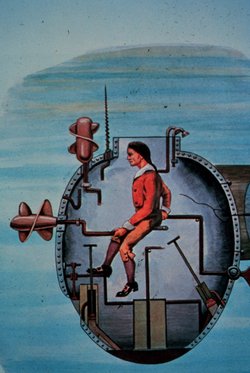Turtle (submarine)
|
|
The Turtle was the first American submarine, invented in Connecticut in 1775 by David Bushnell as a means of attaching explosive charges to ships in a harbor.
Named for its shape, the Turtle resembled a large clam as much as a turtle; it was 7.5 ft long, 6 ft tall, and about 3 ft wide, consisting of two wooden shells covered with tar. It submerged by allowing water into the hull and ascended by pushing water out through a hand pump, similarly to the use of ballast tanks in modern submarines, and was propelled vertically and horizontally by hand-cranked propellors, the first recorded use of the screw propellor for ships. It was not a large submarine, and was manned and operated by only one person. The submarine was designed as a naval weapon, and was meant to drill into a ship's hull and plant a keg of powder, which would be detonated after a certain duration. Much testing was done on the submarine by the inventor's brother, Ezra Bushnell, in the waters of the Connecticut River.
On September 7th, 1776, the Turtle, under the guidance of Army volunteer Sergeant Ezra Lee, attacked the HMS Eagle, which was moored off what is today called Liberty Island, but it could not manage to bore through the hull. When he attempted to try another spot in the hull he lost the ship and eventually Lee abandoned the attempt.
In 1976, a recreation was designed by Joseph Leary and constructed by Fred Frese as a Bicentennial project. It was christened by Connecticut's governor, Ella Grasso, and later tested in the Connecticut River. It is owned by the Connecticut River Museum and is currently on loan to Old Saybrook High School in Old Saybrook, Connecticut. Students at that school are currently working on a working recreation of that model, under the direction of Fred Frese.
Reference
- Alex Roland, Underwater Warfare in the Age of Sail (Indiana University Press, 1978), chaps. 5 and 6 ISBN 0-253-31824-6
External links
- Old Saybrook High School's recreation project (http://www.oldsaybrook.k12.ct.us/HSWebsite/Turtle_Webpage/Turtle.html)
- Turtle Page at the Connecticut River Museum (http://www.ctrivermuseum.org/turtle.htm)

